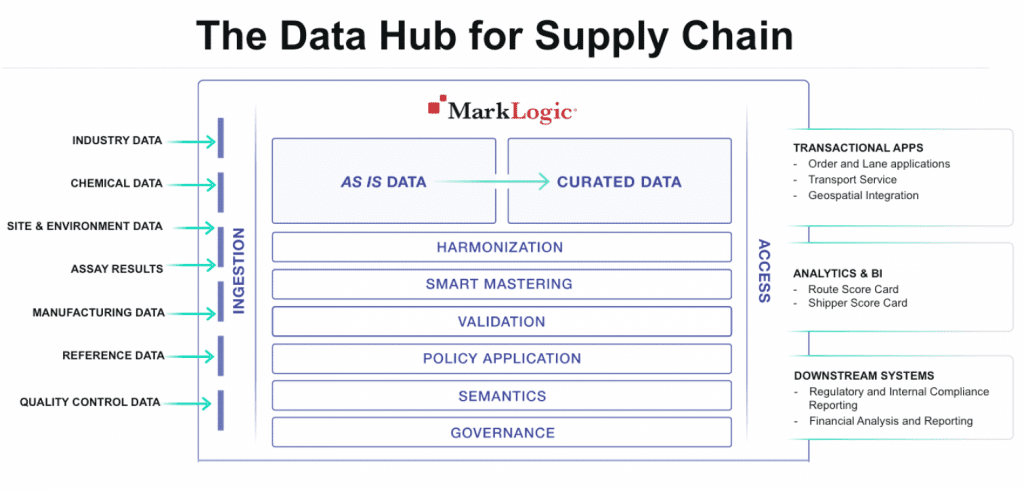Industry 4.0 is revolutionizing the way that data powers manufacturing and supply-chain operations at all levels across every industry. In pharmaceutical manufacturing, Pharma 4.0 is well underway. When we talk about Industry 4.0, we’re referring to the fourth industrial revolution—a stream of innovations that fundamentally changes industrial manufacturing operations. The historical phases of industry can be broken down as follows:
- Mechanization and steam power replace human and animal power.
- Easily commoditized and distributed power—electricity—replaces steam power.
- The Internet arrives and enables new levels of automation.
- Digital and physical technologies are now combining, ushering in the fourth industrial revolution.
Optimizing drug manufacturing and supply-chain practices and operations is part of this new revolution—bringing with it the possibility for the pharmaceutical supply chain to play an important part in reducing risks and costs by adopting modern data practices and technology designed to improve business models and ensure patient health.
In the Xtalks webinar, Disrupting the Life Sciences Supply Chain: Digitizing the Modern Supply Chain by Integrating Industrial Data Across Silos, Amgen’s Dr. Clare Augustine joins Bill Fox, MarkLogic CSO of Healthcare and Life Sciences, and Matt Turner, MarkLogic CTO of Manufacturing, to explore how industry-leading companies are leveraging data across the supply chain to improve operations at less cost.
Examining Supply-Chain Pain Points
The pharma supply chain covers the entire lifecycle of a product, from the factory floor all the way to the customer’s medicine cabinet. Each step, from research and design to final delivery, provides valuable data but can also prove to be a bottleneck that prevents efficient operation.
As demand has grown and technology has become more entrenched in pharmaceutical manufacturing, the pharma supply chain is feeling pressure. Legacy systems, non-digital technology and physical separation create fragmentation in the supply chain. When end-to-end visibility is the goal, fragmentation is the enemy.
Each fragment is a data silo—a barrier to sharing, integrating and analyzing data. Each silo uses its own databases and software, giving very little access to each other’s valuable information. Reporting is difficult. There isn’t a comprehensive view of what’s going on because the data is not being connected.
This fragmentation leads to issues such as process and order-management inefficiencies, unplanned downtime and high quantities of scrap. Each part of the supply chain needs data from the other parts to understand what’s going on, but each part is frustratingly opaque to the others. This contributes to product shortages, excessive inventories and a lack of transparency in shipping and packaging.
Bridging the Digital/Physical Gap
To begin addressing the pain points of the pharma supply chain, the organization needs to bridge the gap between physical and digital resources. Pharma 4.0 aims to build a digital thread that connects data across the business, giving analytical systems an in-depth view of processes in the physical world. This connection between real and virtual is called a cyber-physical system.
Each fragment of the supply chain benefits from the cyber-physical approach. Internet of Things (IoT) devices can be used to monitor everything from manufacturing equipment and pharmaceutical ingredients to shipping materials. All of this data can be used to build new business models and increase operational efficiency.
Modern techniques, such as AI and machine learning, promise to greatly increase the efficiency and safety of the supply chain. However, these technologies are only as useful as the quality and quantity of the data they can access. While a cyber-physical system collects more operational data than ever before, it isn’t necessarily making the data available. Separate systems are tuned for each part of the supply chain.
While there is an agreement that all of this scattered information is valuable, it is still in different formats separated across multiple parts of the supply chain. Without the right data management system, an organization still can’t build the end-to-end view needed to understand their data.
The Operational Data Hub
An Operational Data Hub (ODH) is the key to breaking down data silos and providing the needed visibility between different cyber-physical systems. An ODH eliminates silos and unifies data across the enterprise. This enables efficient data analysis by providing a single source of truth for supply-chain operations. Sharing data through the ODH allows for efficient, comprehensive lot genealogy and batch tracking.
With an ODH, pharmas have better oversight of processes and inventory—reducing waste and scrap while reducing operational inefficiencies. Bringing together data from all segments of the supply chain enables rapid analysis of processes and complete material movement for better forecasting, reduced lead times and inventory optimization.

The Benefits of End-to-End Visibility
By integrating all data into a single source, the MarkLogic ODH achieves a complete view, connecting data from across the entire supply chain. This end-to-end visibility enables better oversight into complex operations.
Counterfeit drug manufacturing generates sales that surpass $200 billion per year, making it the most lucrative enterprise in illegally copied products. It causes devastating harm to millions of people while destroying confidence in the integrity of brands. The comprehensive oversight provided by MarkLogic helps pharmaceutical manufacturers prevent diversion and counterfeiting by simplifying batch tracking.
End-to-end visibility also helps with shipping transparency. Across the organization, different departments can get the data they need to learn the location of a specific batch, how individual orders are being processed and the speed of shipping.
Reduce Costs with a Single Source of Truth
Evolving markets and cost pressures have led to the outsourcing of processes, creating complex and fragmented supply chains. This adds additional challenges to understanding all of the moving parts and data involved, increasing risk and reducing the enterprise’s ability to comply with regulation while threatening brand integrity and revenue.
MarkLogic allows for rapid, multi-structured data integration, which means that even customized, complex supply chains can build a single source of truth—that enable faster identification of areas in need of improvement—at less time and cost.
Learn More


